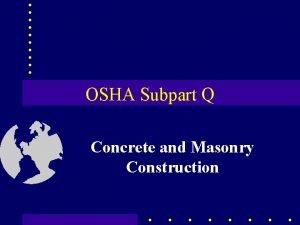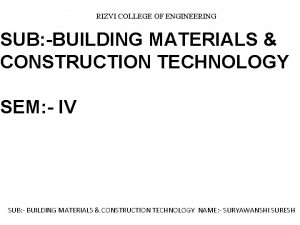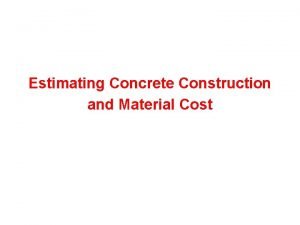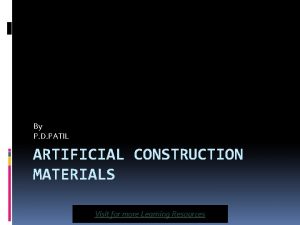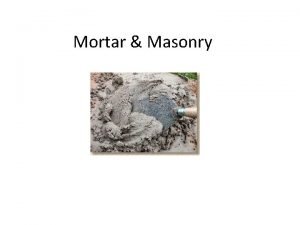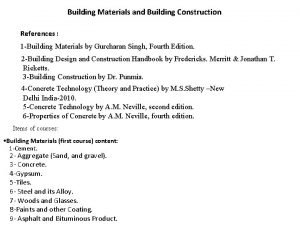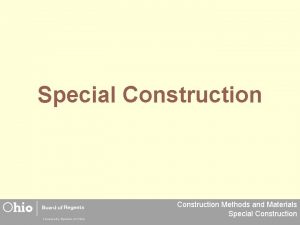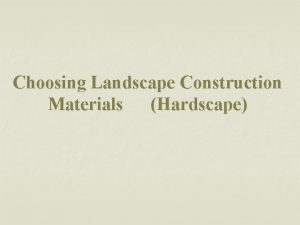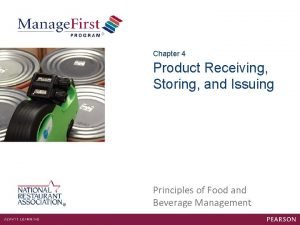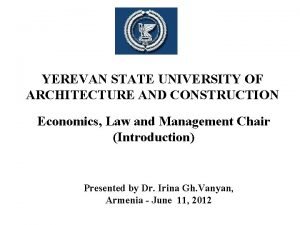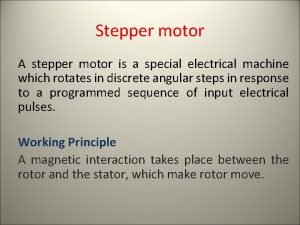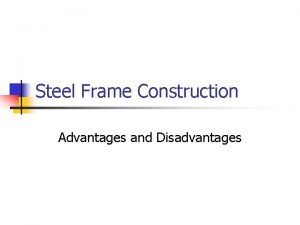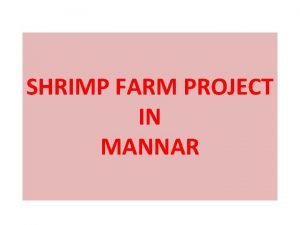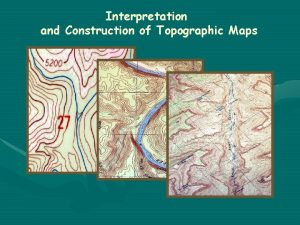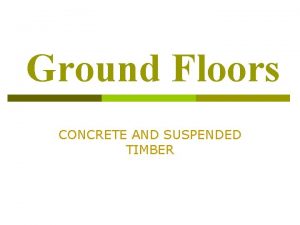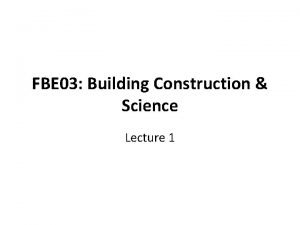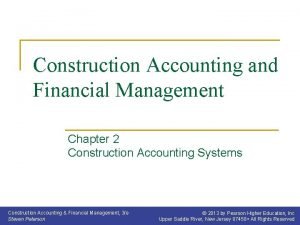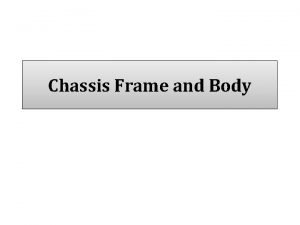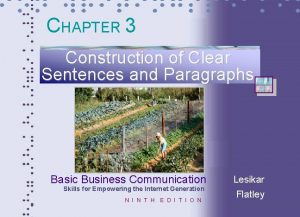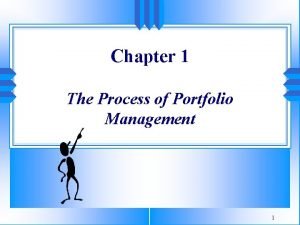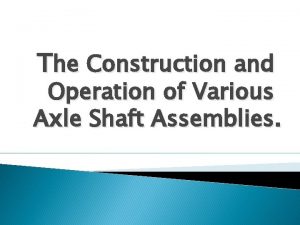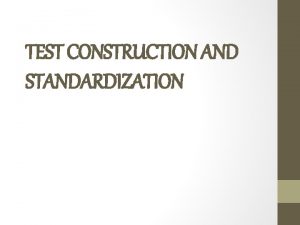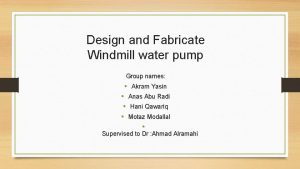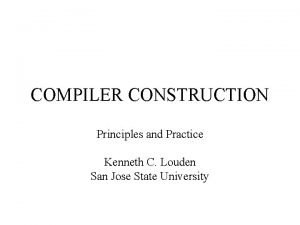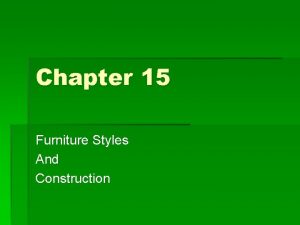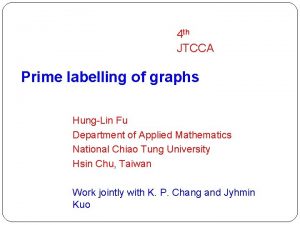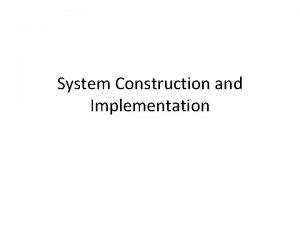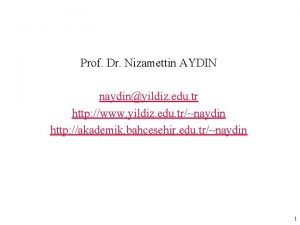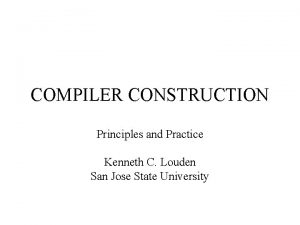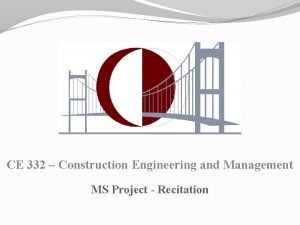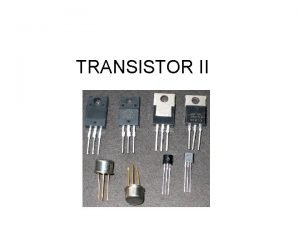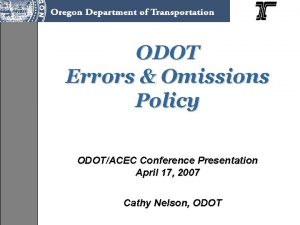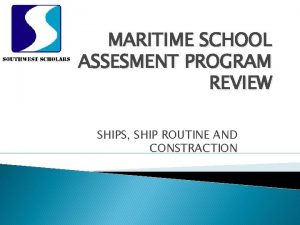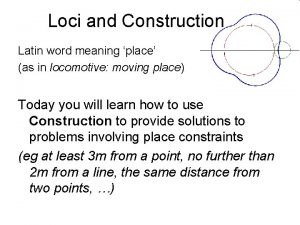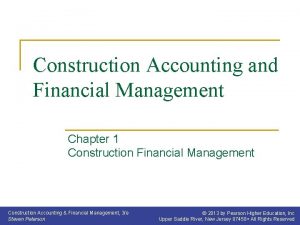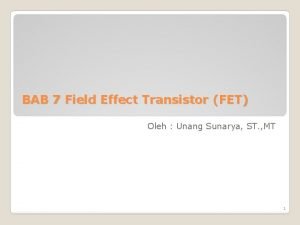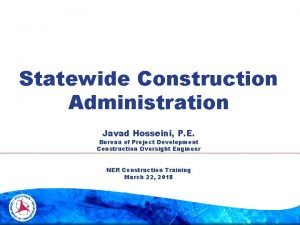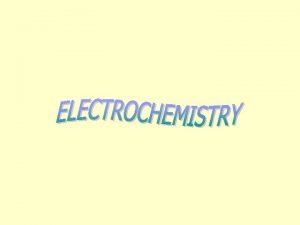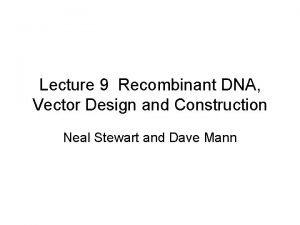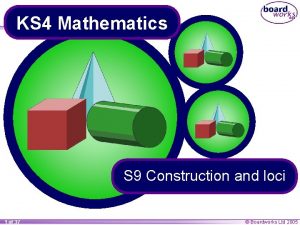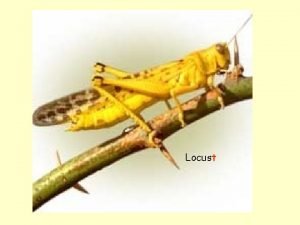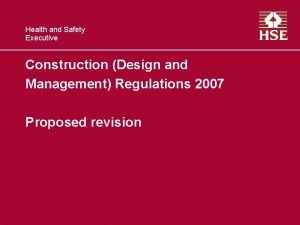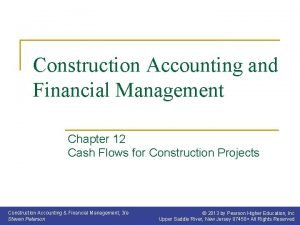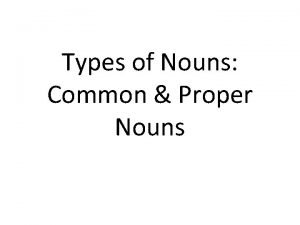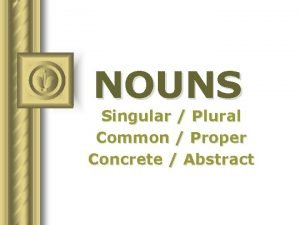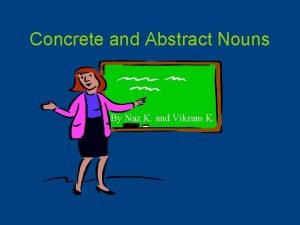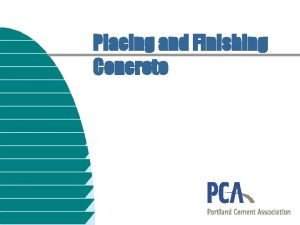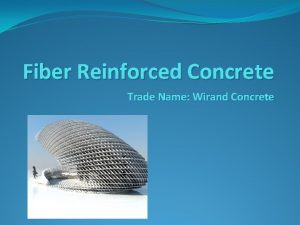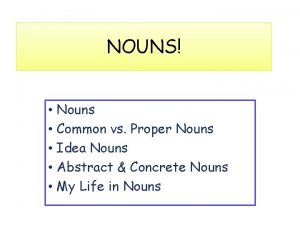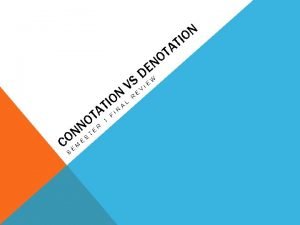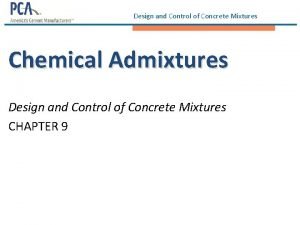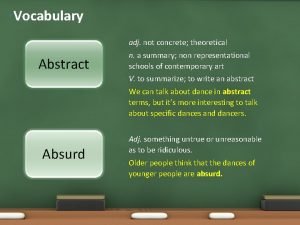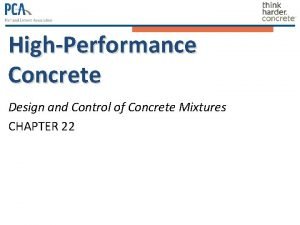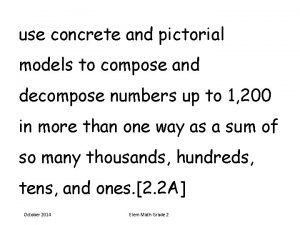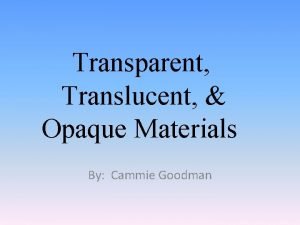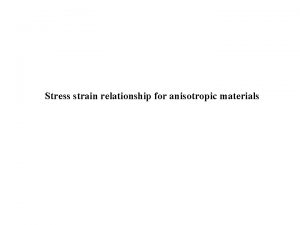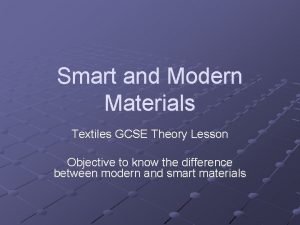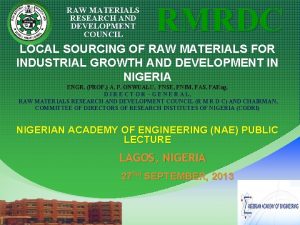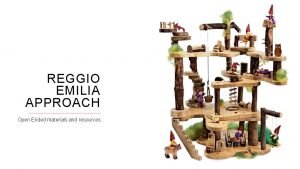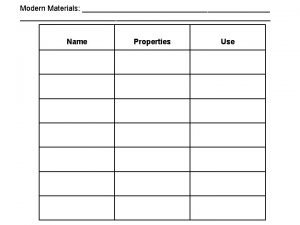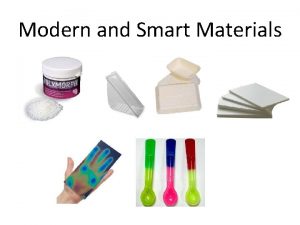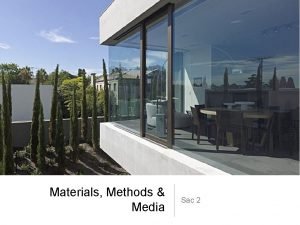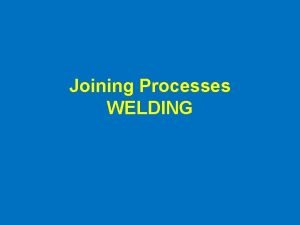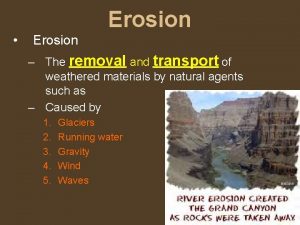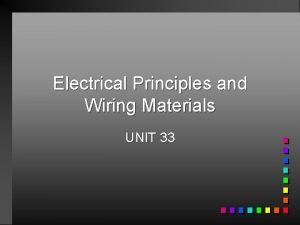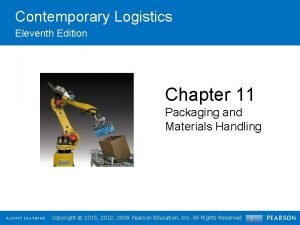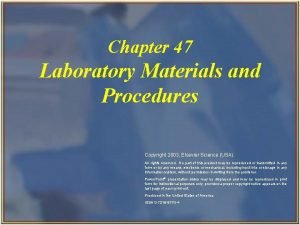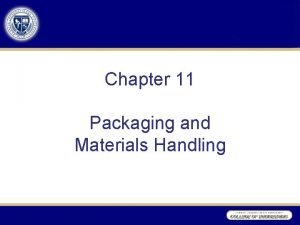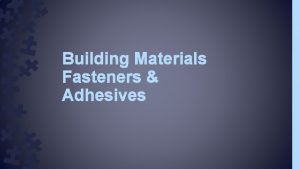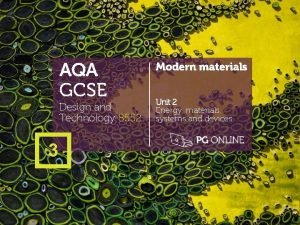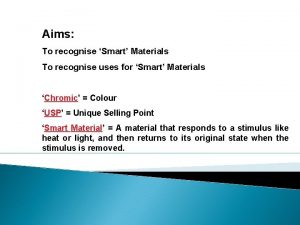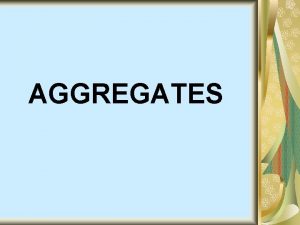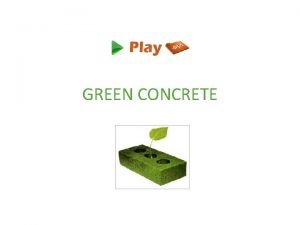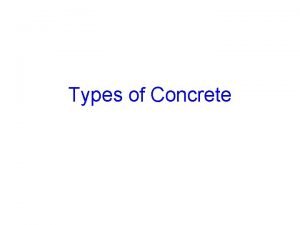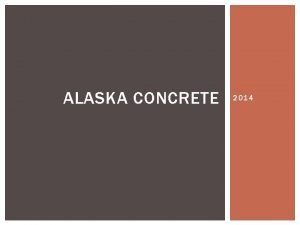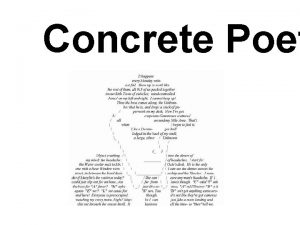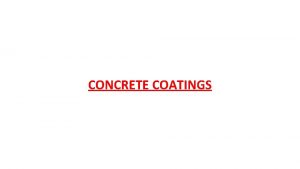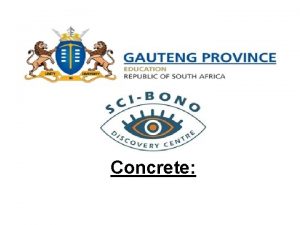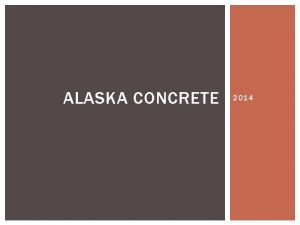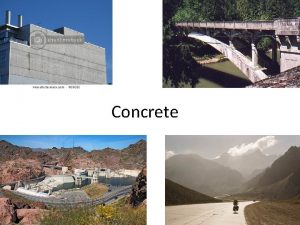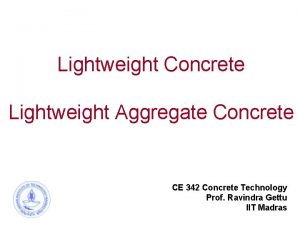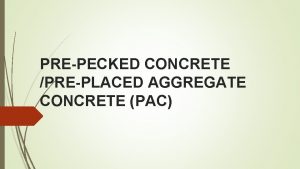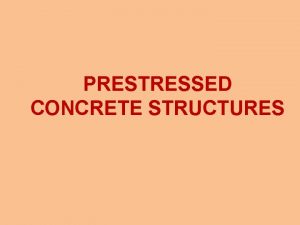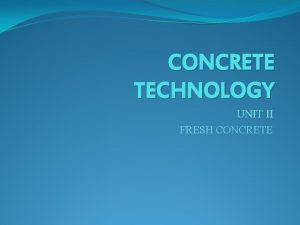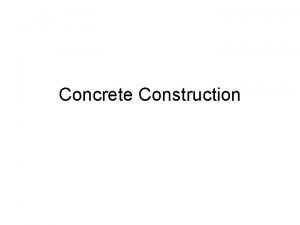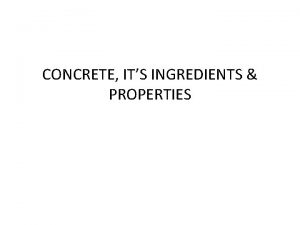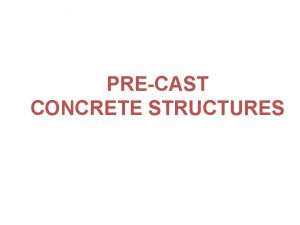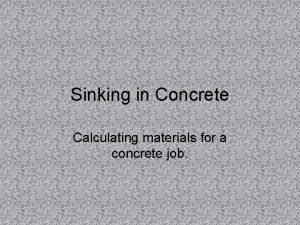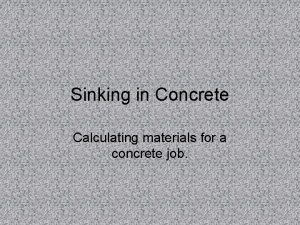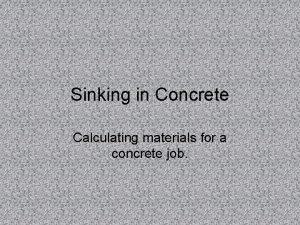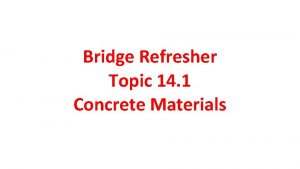1 CONSTRUCTION MATERIALS and CONCRETE WHAT IS CONCRETE











































































































- Slides: 107

1

CONSTRUCTION MATERIALS and CONCRETE

WHAT IS CONCRETE? Construction material Mixture of portland cement, water, aggregates, and in some cases, admixtures. The cement and water form a paste that hardens and bonds the aggregates together. Often looked upon as “man made rock”. Versatile construction material, adaptable to a wide variety of agricultural and residential uses. Strong, durable, versatile, and economical. http: //www. inlandcanada. com/NR/rdonlyres/F 0 EBC 912 -01 A 0 -4 D 58 -AE 7 D 6 F 9 FD 7 DE 0 FF 7/0/Concrete. Recycler 3. jpg CONCRETE

CONCRETE Can be placed or molded into virtually any shape and reproduce any surface texture. The most widely used construction material in the world. In the United States almost twice as much concrete is used as all other construction materials combined. The ready-mix concrete producer has made concrete an appropriate construction material for many applications.

Composition of concrete Water Aggregates Chemical admixtures Cement http: //www. bu. edu/sjmag/scimag 2008/images/Texture__Concrete_Cra cked_by_ivelt_resources. jpg

WATER Good water is essential for quality concrete. Should be good enough to drink--free of trash, organic matter and excessive chemicals and/or minerals. The strength and other properties of concrete are highly dependent on the amount of water and the water-cement ratio. http: //pure-perfection. net/custom/Water-Droplet-1039 X 761. jpg

AGGREGATES Aggregates occupy 60 to 80 percent of the volume of concrete. Sand, gravel and crushed stone are the primary aggregates used. All aggregates must be essentially free of silt and/or organic matter. http: //www. bondedaggregate. co. uk/images/select-aggregatedriveway. jpg

CHEMİCAL ADMİXTURES Materials in the form of powder or fluids that are added to the concrete to give it certain characteristics not obtainable with plain concrete mixes. In normal use, admixture dosages are less than 5% by mass of cement, and are added to the concrete at the time of batching/mixing.

CHEMİCAL ADMİXTURES The most common types of admixtures are: Accelerators : - Speed up the hydration (hardening) of the concrete. - Typical materials used are Ca. Cl 2 and Na. Cl. Acrylic retarders : -Slow the hydration of concrete, and are used in large or difficult pours. - Typical retarder is table sugar, or sucrose (C 12 H 22 O 11).

CHEMICAL ADMIXTURES Air Entraining agents: -The most commonly used admixtures for agricultural concrete. -Produce microscopic air bubbles throughout the concrete. -Entrained air bubbles: Improve the durability of concrete exposed to moisture and freeze/thaw action. Improve resistance to scaling from deicers and corrosive agents such as manure or silage.

CHEMICAL ADMIXTURES Water-reducing admixtures -Increase the workability of plastic or "fresh" concrete, allowing it be placed more easily, with less consolidating effort. -High-range water-reducing admixtures are a class of water-reducing admixtures Increase workability Reduce the water content of a concrete. Improves its strength and durability characteristics.

REINFORCEMENT Strong in compression, as the aggregate efficiently carries the compression load. Weak in tension as the cement holding the aggregate in place can crack, allowing the http: //www. eurocode 2. info/images/rein forcement. jpg structure to fail. Reinforced concrete solves these problems by adding either metal reinforcing bars, steel fibers, glass fiber, or plastic fiber to carry tensile loads.

CEMENT Crystalline compound of calcium silicates and other calcium compounds having hydraulic properties. Considered hydraulic because of their ability to set and harden under or with excess water through the hydration of the cement’s chemical compounds or minerals http: //img. alibaba. com/photo/11654315/Portland_Cement_42_5_N_R. jpg

CEMENT Uses Main use is in the fabrication of concrete and mortars Modern uses -Building (floors, beams, columns, roofing, piles, bricks, mortar, panels, plaster) -Transport (roads, pathways, crossings, bridges, viaducts, tunnels, parking, etc. ) -Water (pipes, drains, canals, dams, tanks, pools, etc. ) -Civil (piers, docks, retaining walls, silos, warehousing, poles, pylons, fencing) -Agriculture (buildings, processing, housing, irrigation)

CEMENT HYDRAULIC CEMENTS: Hydraulic lime: Only used in specialized mortars. Made from calcination of clay-rich limestones. Natural cements: Misleadingly called Roman. It is made from argillaceous limestones or interbedded limestone and clay or shale, with few raw materials. Because they were found to be inferior to portland, most plants switched. Portland cement: Artificial cement. Made by the mixing clinker with gypsum in a 95: 5 ratio.

CEMENT Portland-limestone cements: Large amounts (6% to 35%) of ground limestone have been added as a filler to a portland cement base. Blended cements: Mix of portland cement with one or more SCM (supplementary cemetitious materials) like pozzolanic additives. Pozzolan-lime cements: Original Roman cements. Only a small quantity is manufactured in the U. S. Mix of pozzolans with lime.

CEMENT Masonry cements: Portland cement where other materials have been added primarily to impart plasticity. Aluminous cements: Limestones and bauxite are the main raw materials. Used for refractory applications (such as cementing furnace bricks) and certain applications where rapid hardening is required. It is more expensive than portland. There is only one producing facility in the U. S.

PORTLAND CEMENT Most active component of concrete The greatest unit cost in concrete, Its selection and proper use are important in obtaining most economically the balance of properties desired for any particular concrete mixture. http: //www. cement. org/decorative/images/overview 2. jpg

PORTLAND CEMENT The production process for portland cement first involves grinding limestone or chalk and alumina and silica from shale or clay. Type I/II portland cements are the most popular cements used by concrete producers -Type I cement is the general purpose cement and most common type. Unless an alternative is specified, Type I is usually used. -Type II cement releases less heat during hardening. It is more suitable for projects involving large masses of concrete-heavy retaining walls

Types of Portland cement Cement type Use I 1 General purpose cement, when there are no extenuating conditions II Aids in providing moderate resistance to sulfate attack III When high-early strength is required IV When a low heat of hydration is desired (in massive structures) V When high sulfate resistance is required IA A type I cement containing an integral air-entraining agent IIA A type II cement containing an integral air-entraining agent IIIA A type III cement containing an integral air-entraining agent

PORTLAND CEMENT Physical Properties of Portland Cements 1) 2) 3) 4) 5) 6) 7) Fineness, Soundness Consistency Setting time Compressive strength Heat of hydration Loss of ignition

Concrete production This process develops physical and chemical properties like mechanical strength, low moisture permeability, and chemical and volumetric stability. A properly proportioned concrete mix will provide Mixing concrete Workability Curing

Mixing concrete Essential for I. The production of uniform concrete, II. High quality concrete. Equipment and methods should be capable of effectively mixing http: //en. yujianjx. com/upload/Concrete-Mixing-Plants-HZS 50. jpg

Workability The ease with which freshly mixed concrete can be placed and finished without segregation. Difficult to measure but ready-mix companies usually have experience in determining the proper mix. Important to accurately describe what the concrete is to be used for, and how it will be placed.

Curing Concrete that has been specified, batched, mixed, placed, and finished "letter-perfect" can still be a failure if improperly or inadequately cured. Usually the last step in a concrete project and, unfortunately, is often neglected even by professionals. http: //www. eagleind. com/piclib/324. jpg

Curing has a major influence on the properties of hardened concrete such as durability, strength, water-tightness, wear resistance, volume stability, and resistance to freezing and thawing. Proper concrete curing for agricultural and residential applications involves keeping newly placed concrete moist and avoiding temperature extremes (above 90°F or below 50°F) for at least three days. A seven-day (or longer) curing time is recommended.

Curing The best curing method depends on: Cost, Application equipment required, Materials available, Size and shape of the concrete surface. Prevent the loss of the mixing water from concrete by sealing the surface. Can be done by: Covering the concrete with impervious paper or plastic sheets, Applying membrane-forming curing compounds.

Curing Begin the curing as soon as the concrete has hardened sufficiently to avoid erosion or other damage to the freshly finished surface. Usually within one to two hours after placement and finishing. http: //epg. modot. mo. gov/files/thumb/b/b 2/1055. jpg/400 px-1055. jpg

Properties of concrete Strength Elasticity Cracking Shrinkage cracking Tension cracking

Strength Concrete has relatively High compressive strength, Low tensile strength Fair to assume that a concrete sample's tensile strength is about 10%-15% of its compressive strength The ultimate strength of concrete is influenced by - water-cementitious ratio -the design constituents - the mixing -placement -curing methods

Elasticity Function of the modulus of elasticity of the aggregates and the cement matrix and their relative proportions The American Concrete Institute allows the modulus of elasticity to be calculated using the following equation: where wc = weight of concrete (pounds per cubic foot) and where f'c = compressive strength of concrete at 28 days (psi)

Cracking All concrete structures will crack to some extent. Cracks due to tensile stress induced by shrinkage or stresses occurring during setting or use

Shrinkage cracking Occur when concrete members undergo restrained volumetric changes (shrinkage) as a result of either drying, autogenous shrinkage or thermal effects. The number and width of shrinkage cracks that develop are influenced by -the amount of shrinkage that occurs -the amount of restraint present -the amount and spacing of reinforcement provided. http: //epg. modot. org/files/thumb/3/39/216_Remo val_of_existing_expansion_joint. jpg/550 px 216_Removal_of_existing_expansion_joint. jpg

Tension cracking Most common in concrete beams where a transversely applied load will put one surface into compression and the opposite surface into tension due to induced bending. The size and length of cracks is dependent on - The magnitude of the bending moment - The design of the reinforcing in the beam at the point under consideration.

Types of concrete Ø Regular concrete Ø High-strength concrete Ø Stamped concrete Ø High-performance concrete Ø Self-consolidating concretes Ø Vacuum concretes Ø Shotcrete Ø Pervious concrete Ø Cellular concrete, Ø Cork-cement composites Ø Roller-compacted concrete Ø Ø Ø Glass concrete Asphalt concrete Rapid strength concrete Rubberized concrete Polymer concrete Geopolymer or green concrete Limecrete Refractory Cement Concrete cloth Innovative mixtures Gypsum concrete

Concrete testing Compression testing of a concrete cylinder http: //www. antouncivil. com. au/vca/Images/testing. jpg Same cylinder after failure http: //www. concrete-curb. com/wpcontent/uploads/Breakage. Cylinder. jpg

General test methods Compaction Factor Test (Compacting Factor Test, Glanville) Compaction Test Free Orifice Test (Orimet Test) n Cone Penetration Test K-Slump Tester n Moving Sphere Viscometer Free Flow Test Methods n Flow Trough Test Slump Test n Delivery-Chute Torque Meter Modified Slump Test n Delivery-Chute Depth Meter Slump Rate Machine n Surface Settlement Test Kelly Ball Test Ring Penetration Test

Concrete recycling increasingly common method of disposing of concrete structures recycling is increasing due to -improved environmental awareness - governmental laws -economic benefits Recycling concrete provides -environmental benefits -conserving landfill space

Construction materials Asphalt Aggregate Brick Gypsum

ASPHALT Also known as bitumen Dark brown to black Highly viscous Hydrocarbon produced from petroleum distillation residue. At least 80% carbon, which explains its deep black color. Sulphur is another ingredient. Primarily used as a sealant for rooftops and a durable surface for roads, airport runways, playgrounds and parking lots. http: //www. ekocozum. com/blog/wpcontent/uploads/2008/05/asfalt. jpg

the other components in crude oil By the process of fractional distillation, usually under vacuum conditions. http: //www. cranedigital. com/case_studies/oil_and_gas/fractional_distillation_column 2. jpg ASPHALT Asphalt can be separated from

TYPES OF ASPHALT http: //www. pkeenanroads. com/wp-content/gallery/stone/rolled. jpg http: //www. highwaysmaintenance. com/JPEGsurf/smis. SMA. jpg The major types of asphalt used in construction are ; Rolled asphalt Mastic asphalt.

Rolled Asphalt Made of aggregate, or solid materials such as sand, gravel, or recycled concrete, with an asphalt binder. Used to make roads and other surfaces, such as parking lots, by being applied in layers and compacted. Different types of rolled asphalt are distinguished according to the process used to bind the aggregate with the asphalt.

TYPES OF ROLLED ASPHALT Hot mix asphalt concrete (HMAC) - Produced at 160 degrees Celsius. -This high temperature serves to decrease viscosity and moisture during the manufacturing process, resulting in a very durable material. -HMAC is most commonly used for high-traffic areas, such as busy highways and airports. http: //www. crossroadspaving. com/images/asphalt-paving-repair. jpg

ROLLED ASPHALT Warm mix asphalt concrete (WAM or WMA) -Reduces the temperature required for manufacture by adding asphalt emulsions, waxes, or zeolites. -Benefits both the environment and the workers, as it results in less fossil fuel consumption and reduced emission of fumes. http: //www. wispave. org/images/i. Stock_000007064664 XSmall. jpg

ROLLED ASPHALT Cold mix asphalt concrete, -Emulsified in soapy water before mixing it with the aggregate, eliminating the need for high temperatures altogether. -The asphalt produced is not nearly as durable as HMAC or WAM -Typically used for low traffic areas or to patch damaged HMAC. http: //www. dykespaving. com/wp-content/themes/classic/images/coldmix. jpg

ROLLED ASPHALT Cut-back asphalt concrete -Illegal in the United states since the 1970 s, but many other countries around the world still use it. -The least environmentally friendly option, resulting in significantly more air pollution than the other forms. -Made by dissolving the asphalt binder in kerosene beforemixing it with the aggregate, reducing viscosity while the concrete is layered and compacted.

MASTIC ASPHALT Also called sheet asphalt. Lower bitumen content than the rolled asphalt. Used for some roads and footpaths. Used also in roofing and flooring. http: //www. e 470. com/images/news. SMAfullsized. jpg

MASTIC ASPHALT Stone mastic asphalt (SMA), is another variety. Becoming increasingly popular as an alternative to rolled asphalt. Benefits include -Anti-skid property -The absence of air pockets But if laid improperly -May cause slippery road conditions.

PHYSICAL PROPERTIES OF ASPHALT Durability - A measure of how asphalt binder physical properties change with age. - Sometimes called age hardening. - In general, as an asphalt binder ages, its viscosity increases and it becomes more stiff and brittle.

PHYSICAL PROPERTIES OF ASPHALT Rheology The study of deformation and flow of matter. Deformation and flow of the asphalt binder in HMA is important in HMA performance. HMA pavements that deform and flow too much may be susceptible to rutting and bleeding, while those that are too stiff may be susceptible to fatigue cracking.

PHYSICAL PROPERTIES OF ASPHALT Safety Asphalt cement like most other materials, volatilizes (gives off vapor) when heated. Flash point. For safety reasons, the flash point of asphalt cement is tested and controlled. Purity. Asphalt cement, as used in HMA paving, should consist of almost pure bitumen. Impurities are not active cementing constituents and may be harmful to asphalt performance.

AGGREGATE Collective term for sand, gravel and crushed stone mineral materials in their natural or processed state Roads and highways constitute the largest single use of aggregate at 40 percent of the total

AGGREGATE ORIGINS AND PRODUCTION Can either be natural or manufactured I. Natural aggregates are generally extracted from larger rock formations through an open excavation II. Manufactured rock typically consists of industrial byproducts such as slag (byproduct of the metallurgical processing – typically produced from processing steel, tin and copper) Specialty rock that is produced to have a particular physical characteristic not found in natural rock (such as the low density of lightweight aggregate).

AGGREGATE PHYSICAL PROPERTIES Toughness and abrasion resistance. Aggregates should be hard and tough enough to resist crushing, degradation and disintegration from activities such as manufacturing, stockpiling, production, placing and compaction. Durability and soundness. Aggregates must be resistant to breakdown and disintegration from weathering (wetting/drying) or else they may break apart and cause premature pavement distress.

Particle shape and surface texture are important for proper compaction, load resistance and workability. Generally, cubic angular-shaped particles with a rough surface texture are best. Specific gravity. Aggregate specific gravity is useful in making weight-volume conversions and in calculating the void content in compacted Hot Mixed Asphalt Cleanliness and deleterious materials. Aggregates must be relatively clean when used in HMA. Vegetation, soft particles, clay lumps, excess dust and vegetable matter may affect performance by quickly degrading, which causes a loss of structural support and/or prevents binder-aggregate bonding

GYPSUM Occurs in nature as : - flattened - often twinned crystals - transparent cleavable masses called selenite. May also occur in a silky, fibrous form, in which case it is commonly called satin spar. Finally may also be granular or quite compact. In hand-sized samples. Can be transparent or opaque. http: //www. warmtec. co. nz/mediac/400_0/media/variotherm 3. JPG

A common mineral, with thick and extensive evaporite beds in association with sedimentary rocks. Gypsum is deposited in lake and sea water. Hydrothermal anhydrite in veins is commonly hydrated to gypsum by groundwater in near surface exposures. Often associated with the minerals halite and sulfur. http: //en. wikipedia. org/wiki/Gypsum

USES OF GYPSUM Gypsum Board primarily used as a finish for walls and ceilings; known in construction slang as Drywall Plaster ingredient. A component of Portland cement used to prevent flash setting of concrete.

BRICK Masonry unit Does not infer any particular material About %90 of UK, bricks made from some form of clay. %8 of UK bricks made of concrete crushed rock aggregate and portland http: //www. urbanrevivals. com/images/brick_all_web. jpg cement are main constituents. %3 of UK of brick made from sand lime, sometimes with the addition of crushed flint.

REFERENCES WEB, http: //www. fhwa. dot. gov/infrastructure/materialsgrp/cement. html WEB , http: //www. concrete. org/general/f. E 4 -03. pdf WEB, http: //architecture. arqhys. com/construction/properties-asphalt. html WEB, http: //www. cement. org/basics/concretebasics_aggregate. asp Standard specification for portland cement (AASHTO M 85 -89). 1986. AASHTO standard specification for transportation materials. Part I, Specifications. 14 th ed. Powers, T. C. , L. E. Copeland, J. C. Hayes, and H. M. Mann. 1954. Permeability of portland cement paste. ACl Journal Proceedings 51 (3): 285 -98. Whiting, D. 1988. Permeability of selected concretes. ACI special publication. Permeability of concrete SP-108: 195 -222. Tsuji, Y. , and N. Miyake. 1988. Chemically prestressed precast concrete box culverts. Concrete International: Design and Construction 10 (5): 76 -82 (May). Ramachandran, V. S. , and R. F. Feldman. 1984. Cement science. In Concrete admixtures handbook: Properties, science, and technology, ed. V. Ramachandran, 1 -54. Park Ridge, N. J. : Noyes Publications.

Thank you for your attention Simple question about our presentation. 1. What is the composition of concrete? 2. What is the purpose of curing? 3. What is the types of asphalt mostly used in construction? 4. What type of construction material is used for lining the kilns?

Wood An Ancient building Material By Engr. Dr. Attaullah Shah SWEDISH COLLEGE OF ENGINEERING AND TECHNOLOGY 63

Wood

Wood and Timber Wood is a hard, fibrous tissue found in many plants. It has been used for centuries for both fuel and as a construction material for several types of living areas such as houses, known as carpentry. In the United Kingdom and Australia, timber is a term also used for sawn wood products (that is, boards), whereas generally in the United States and Canada, the product of timber cut into boards is referred to as lumber. Throughout history, the unique characteristics and comparative abundance of wood have made it a natural material for homes and other structures, furniture, tools, vehicles, and decorative objects. Today, for the same reasons, wood is prized for a multitude of uses. Types: Wood suitable for buildings: Timber Woof of fallen tree: Rough Timber Sawed and finished wood: Converted Timber /Lumber All wood is composed of cellulose, lignin, hemicelluloses, and minor amounts (5% to 10%) of extraneous materials contained in a cellular 65

Types of Trees: Exogenous Trees/ Endogenous Exogenous Trees Grow in girth and material contained in the bark. Most of the building wood In the form of concentric rings called ‘”Annual rings” Normally one rings represents one year growth Endogenous Trees: Grows inwards by adding every year a fresh layer of internally The older formation are outside Flexible and slender and not fit for buildings Deciduous/Evergreen Trees: Shed their leaves each winter –Building wood mostly Evergreen: Don’t shed leaves every winter 66

X-section of tree: Bark, Wood, Branches, and Cambium Cross section of white oak tree trunk: (A) outer bark (dry dead tissue): outer corky dead part (A), whose thickness varies greatly with species and age of trees (B) inner bark (living tissue): which carries food from the leaves to growing parts of the tree; (C) cambium: Outer ring between the sapwood and bark Lighter, weaker and vulnerable to decay. (D) sapwood: Transmits the sap from roots to branches (E) heartwood, (F) pith, and (G) wood rays. 67

Sapwood and Heartwood: Sapwood is located between the cambium and heartwood Sapwood contains both living and dead cells and functions primarily in the storage of food; In the outer layers near the cambium, sapwood handles the transport of water or sap. The sapwood may vary in thickness and number of growth rings. Sapwood commonly ranges from 4 to 6 cm (1 -1/2 to 2 in. ) in radial thickness. In certain species, the sapwood contains few growth rings and usually does not exceed 1 cm (1/2 in. ). As a rule, the more vigorously growing trees have wider sapwood. Many second-growth trees of merchantable size consist mostly of sapwood. . 68

In general, heartwood consists of inactive cells that function in either water conduction or food storage. The transition from sapwood to heartwood is accompanied by an increase in extractive content. Frequently, these extractives darken the heartwood and give species such as black walnut and cherry their characteristic color 69

Growth Rings In most species in temperate climates, the difference between wood that is formed early in a growing season and that formed later is sufficient to produce well-marked annual growth rings. The age of a tree at the stump or the age at any cross section of the trunk may be determined by counting these rings. However, if the growth in diameter is interrupted, by drought or defoliation by insects for example, more than one ring may be formed in the same season. In such an event, the inner rings usually do not have sharply defined boundaries and are termed false rings. Trees that have only very small crowns or that have accidentally lost most of their foliage may form an incomplete growth layer, some times called a discontinuous ring. 70

Cross section of pine log showing growth rings. Light bands are early wood , dark bands latewood. An annual (growth) ring is composed of an inner early wood zone and outer latewood zone. 71

Cutting and Sawing Lumber Shrinkage, distortion, and warpage of lumber depends partially on the way lumber is cut from a tree. Wood shrinks most in the direction of the annual growth rings (tangentially); less across these rings (radially); and very little parallel to the grain (longitudinally).

Cutting and Sawing Lumber can be cut from a log in two different ways: tangent to the annual rings, called plain-sawed in hardwoods and flatgrained or slain-grained in softwoods. Lumber cut radially to the annual rings is called quarter-sawed in hardwoods, and edge-grained or vertical-grained in softwoods.

Cutting and Sawing Lumber is classified as quarter-sawed if the grain is 45 degrees to 90 degrees to the wide face and plain-sawed if the grain is 0 degrees to 45 degrees to the wide face.

Cutting and Sawing Lumber Characteristics of plain-sawed lumber include: 1. Distinct grain pattern, 2. May twist, cup, or wear unevenly, 3. Tends to have a raised grain, 4. Shrinks and swells more in width, less in thickness, 5. Less waste in cutting, and therefore less expensive.

Cutting and Sawing Lumber Characteristics of Quarter-sawed lumber include: 1. Relatively even grain pattern, 2. Wears evenly with less warpage, 3. Shrinks and swells more in thickness, less in width, 4. More waste in cutting and therefore more costly.

Wood Defects Variety of defects that affect the strength, appearance, use, and grading of lumber. Defects may be natural or caused by manufacturing. Wood can be damaged by insects, decayed by fungus, and of course, destroyed by fire. 77

Wood Defects NATURAL DEFECTS: Knot: branch embedded in a tree and cut through manufacturing. Shake: pitted area sometimes found in cedar and cypress. Pitched Pocket: opening between growth rings and containing resin. Check: lengthwise grain separation caused by seasoning. Split: lengthwise separation of wood extending from one face to another. Wane: lack of wood on the edge or corner. Warp: shrinkage distortion of a plane surface, includes---bow, crook, cup and twist.


Seasoning of wood seasoning is process of drying out timber after conversion. (Conversion felled trees are converted in sawmills into thick plank sizes). Freshly cut wood contains considerable water, which amounts to from one-third to more than one-half of the total weight. The drying of wood before it is processed into timber is called seasoning, and is done for a number of reasons. Seasoned wood is far more resistant to decay than fresh wood; 80

it is much lighter and therefore less expensive to ship; it has much higher heating value, which is important if it is to be used as fuel; and, most important, wood changes in shape during drying, and this change in shape should be completed before the wood is worked or used. Wood may be seasoned either by air-drying or kiln-drying. Air-drying takes several months, whereas kiln-drying takes a few days. In both cases, the wood must be carefully stacked to prevent warping, and the rate of drying must be carefully controlled. 81

Wood Seasoning Methods Air Seasoning – the natural method. Boards are stacked in the open air with sticks (thin strips of wood) between them to allow air to circulate. The stack is raised clear of the ground on piers and has a roof to protect it from the weather. The ends of the boards are painted, or have cleats (wood or metal strips) nailed across them to prevent the end grain drying more quickly than the rest of the board, as this causes splitting (checking). Advantages. It is cheap and needs little skilled attention. Disadvantages. It takes 3 to 6 years to dry. The moisture content can only be reduced to 15 – 18% by air seasoning.

Kiln Seasoning – the artificial method. Boards are stacked on trolleys with sticks between them, and pushed into a kiln. The kiln is sealed and seasoning proceeds in three stages. Stage 1. Steam is injected at low temperature to force free moisture out of the wood cells. Stage 2. Steam is reduced and the temperature is increased to dry the wood Stage 3. Finally there is a flow of hot, almost dry, air. Advantages. It takes only a few days or weeks and kills insect eggs in the wood (e. g. woodworm). It is possible to reduce moisture content to below 12%, making the wood suitable for use in centrally heated and air-conditioned buildings Disadvantages. Kilns are expensive to build and to run. It needs a more attention and a lot of skill as incorrect drying will ruin he wood. 83

Water seasoning: Large logs are immersed in water for 15 days. Later dried in the open air. Suitable for wood containing more sap. Not suitable where strength is required like structural uses. Most of the fermentable matters removed and wood less vulnerable to attacks of worms. Chemical seasoning or salt seasoning: Timber soaked in the solution of urea. Later dried in kiln. Electric seasoning: Quick but expensive. High frequency AC currents passed in the wood. 84

Characteristics of good Timber Quality of timber depends on: Species used, the soil where tree is grown, time of felling and methods of seasoning and treatment. Free of defects like knots, wanes, etc. Obtained from hearth of sound treed and sap removed. Uniform structure and color. Narrow annual rings. Heavier in weight Firm adhesion of fibers. 85

Causes of wood decay and preservation Wood is naturally a very durable substance. If not attacked by living organisms, it will last for hundreds or even thousands of years. Samples of wood used by the ancient Romans have been found virtually in their original condition when a combination of circumstances protected them against attack. The most important of the organisms attacking wood are the fungi that cause so-called dry rot, which actually occurs only when the wood is damp. The sapwood of all trees is susceptible to this type of decay, but the heartwood of a few species is naturally resistant to these fungi. Walnut, redwood, cedar, mahogany, and teak are among the well-known woods that are extremely durable Other woods are resistant to various types of attack. Greenheart and teak are particularly resistant to the attack of marine borers, and so are often used for underwater construction for wharves. A number of woods are comparatively resistant to termites, including redwood, black walnut, mahogany, and several types of cedar. In most of these cases, the woods are aromatic, and the resistance is probably due to the resins and similar chemicals they contain. 86

Wood may be preserved by protecting it chemically against deterioration. The most important method of treatment has long been impregnation with creosote or zinc chloride. This method is still one of the best, although a number of newer chemicals, notably several containing copper compounds, have been introduced for the same purpose. Wood can be protected against weathering by suitable surface coatings, applied by brushing, spraying, or dipping. Surface applications yield little penetration, however, and therefore do not prevent deterioration under attack by insects, fungi, or borers. By applying a finish to wood we not only protect it but tend to improve its appearance. A highly polished dining table or floor is not only safe from attack by organisms and chemicals they become more attractive or aesthetically pleasing. New paints and coatings are constantly being developed to improve and enhance the appearance and properties of both natural and processed wood 87

Commonly used wood preservation techniques: A good preservative must be: Cheap - Easy to use and handle - Non injurious to the tissues of trees- Should preserve permanently and must not wash. Should not affect the color of the wood. Methods of Preservation Brush treatment and painting 2 -4 coats of oil, paint or creosote Charring of timber: Charring the outer fibers of timber by fire Envelop of charcoal is devoid of food and restricts fungi. Reduces the strength as burns the outer fibers. Dipping: Dipped in preservative and soaked for few minutes. Used for lower ends of poles and wooden piles. Creosoting; Moisture extracted and the vacuum filled with creosote Creosote is by-product coal tar produced in manufacture of coal gas 88

Engineered Wood Products OSB LVL Plywood Particle Board Glulam MDF I-Beams Trusses

Particle Board manufactured from wood particles, such as wood chips, sawmill shavings, or even saw dust. Made with larger pieces of wood than used to make MDF

Chipboard or Particleboard Most chipboard is of graded density, having smaller chips packed tightly together on the outside to give a smoother and stronger face. Chipboard is made by gluing wooden chips together under heat and pressure. It is suitable only for interior use. Veneered and melamine-faced chipboard is widely used for worktops, shelves and furniture making. Usual sheet size is 2240 x 1220 mm. Common thicknesses are 12 mm and 18 mm.

Blockboard and Laminboard These are made by sandwiching strips of softwood between two plies. The strips are narrower in laminboard than in blockboard. They are usually made in interior grade only. The grain of the face plies runs at right angles to the core strips. The core strips are arranged with the heartside alternately on top and underneath (as when edge jointing boards) to avoid warping. Both block and laminboard can be faced with veneers of decorative hardwood. It is usually cheaper to make blockboard than to make multiply over 12 mm thick. Usual sheet size is 2440 x 1220 mm. Common thickness is 18 mm.

Hardboard is made by mixing wood fibres with water and synthetic resin glue, hot-pressing it into sheets and leaving it to dry. It is not very strong and is usually fixed onto a wooden frame. Standard grade is for interior use. Tempered grade is impregnated with oil for exterior use and for bending to make curved shapes. Can be melamine-faced or ready painted.

Medium Density Fibreboard (MDF) A fairly new material (1979) but extensively used that is like a very smooth chipboard. Fibreboard is made from a pulp of wood or other vegetable fibres which is dried under heat and pressure. For adhesion it relies principally on the natural resin contained in the pulp. It is used for model-making, light structural items such as speaker cabinets and extensively for furniture – wardrobes kitchen units etc. Usual sheet size is 2240 x 1220 mm but may be supplied in half or quarter sheets. MDF is available in a large range off thickness from 5 mm to over 50 mm.

Oriented Strand Board (OSB)

Oriented Strand Board (OSB)

Laminate Strand Lumber (LSL) Made up of strands of lumber instead of veneers

Laminated Veneer Lumber (LVL) LVL is made by gluing sheets of veneer together. Unlike plywood, here all veneer layers are going in the same direction. Wide panels are manufactured to the thickness of the desired lumber. The panels are ripped into lumber of nominal width.

Masonite Type of hardboard invented by William H. Mason. It is formed using the Mason method, using wooden chips and blasting them into long fibers with steam and then forming them into boards. The boards are then pressed and heated to form the finished boards. No glue or other material is added.

Plywood made from thin sheets of wood veneer, called plies or veneers, layered in opposite directions

WOOD MATERIAL THEORY Plywood This is made from layers or plies of wood glued together so that the grain of each ply is at right angles to the next. There is always an odd number of plies so that the grain runs the same way on both outside pieces and hence stresses are balanced. Traditional 5 - plywood Direction of layers at 90 degrees to each other

WOOD MATERIAL THEORY Plywood can be faced with a veneer of decorative hardwood to improve its appearance, or with melamine to give a harder wearing surface. Plywood is graded for interior or exterior use depending on the water resistance of the glue used, and this is shown by code letters on each sheet. WBP – Weather and boil proof. BR – Boil resistant MR – Moisture resistant Int. – Interior use only Plywood is also graded by the smoothness of the surface and number of defects in it. Plywood can be nailed near the edge without splitting. Thin plywood is flexible and can be formed into curved shapes. Usual sheet sizes are 2440 x 1220 mm and 1525 x 1525 mm. Common thicknesses are 4, 6, 9 and 12 mm.

Wood I-Beams Veneer lumber is used for the flanges and plywood or OSB is used for the web to resist shear.

Glued Laminated Lumber (Glulam) These beams are made by gluing many boards together to form a structural member bigger than the trees from which the board were sawn. Since the load is carried by the material in the top and bottom faces and the middle only has to resist shear, high quality lumber is used in the top and bottom while medium grade lumber is used in the center. (gluelam or glulam) Joints between boards are typically scarf of finger joints.

Wood Trusses

Important Wood types Deodar ( Cedrus Deodara) Kail ( Biar) or Blue Pine ( Pinus excelsa) Chir ( Pine) ( Pinus Longifolia) Bamboo or Bans ( Bambusa). Jaman Mango Neem Olive Phulai Shishum ( Tali) Teak or Sagwan. 106

Group Assignment G-1: Write the names of most commonly used two softwoods and two hardwoods. Explain their properties and uses in Civil Engineering. G-2: Explain various methods for seasoning of wood. G-3: Types and uses of Engineered Wood G-4: Structural uses of Wood in Civil Engineering G-5: Characteristics of Good Quality Wood. G-6: Compare Plywood and Laminated Veneered Lumber ( LVL) G-7: Common Types of Defects in Wood and their remedies 107
 According to subpart q which of the following
According to subpart q which of the following What is the name of the building
What is the name of the building Natural materials
Natural materials Example of useful and harmful
Example of useful and harmful Man made materials
Man made materials Differentiate adopting materials and adapting materials
Differentiate adopting materials and adapting materials Concrete weights and measures
Concrete weights and measures Artificial construction materials
Artificial construction materials Surkhi construction materials
Surkhi construction materials Reference construction
Reference construction Special construction examples
Special construction examples Landscape construction materials
Landscape construction materials Concrete semi concrete abstract
Concrete semi concrete abstract Concrete semi concrete abstract
Concrete semi concrete abstract Direct materials budget with multiple materials
Direct materials budget with multiple materials Stock receiving and issuing procedures
Stock receiving and issuing procedures The common materials needed in making electrical
The common materials needed in making electrical Yerevan state university of architecture and construction
Yerevan state university of architecture and construction Stepper motor construction and working
Stepper motor construction and working Advantages and disadvantages of structural steel
Advantages and disadvantages of structural steel Shrimp farming powerpoint presentation
Shrimp farming powerpoint presentation Reversed sentence construction in romeo and juliet
Reversed sentence construction in romeo and juliet Network design and construction
Network design and construction Ogs design and construction
Ogs design and construction Trunk and distribution construction
Trunk and distribution construction Topographic map interpretation
Topographic map interpretation Murphy repertory rubrics
Murphy repertory rubrics Suspended timber floor advantages
Suspended timber floor advantages Strutting in construction
Strutting in construction Msc construction law and dispute resolution
Msc construction law and dispute resolution Construction cost accounting basics
Construction cost accounting basics Frame and frameless construction in automobile
Frame and frameless construction in automobile Construction paragraph
Construction paragraph Portfolio construction management and protection
Portfolio construction management and protection Feedlot design and construction
Feedlot design and construction Rear axle construction
Rear axle construction Test construction and standardization
Test construction and standardization Strict interpretation
Strict interpretation Interpretation and construction
Interpretation and construction Windmill water pump design and construction
Windmill water pump design and construction Distinguish between realism and construction
Distinguish between realism and construction Compiler construction principles and practice pdf
Compiler construction principles and practice pdf Chapter 15 furniture styles and construction answer key
Chapter 15 furniture styles and construction answer key Construction and labelling of graphs
Construction and labelling of graphs System construction and implementation
System construction and implementation E and c construction
E and c construction Compiler construction principles and practice
Compiler construction principles and practice Design prototyping and construction
Design prototyping and construction Construction engineering and management
Construction engineering and management 1b transistor
1b transistor Errors and omissions definition construction
Errors and omissions definition construction Flounder plate ship
Flounder plate ship Latin word for equal
Latin word for equal Construction accounting and financial management
Construction accounting and financial management Terminal fet
Terminal fet Principal of incubator
Principal of incubator Career cluster definition
Career cluster definition Vertical construction
Vertical construction Statewide construction and development
Statewide construction and development Weston cadmium cell construction and working
Weston cadmium cell construction and working Dna vector design
Dna vector design Loci meaning maths
Loci meaning maths Passive and active construction
Passive and active construction Loci and construction o level
Loci and construction o level Health and safety executive construction
Health and safety executive construction Construction accounting and financial management
Construction accounting and financial management Common noun vs proper noun
Common noun vs proper noun Target strength of concrete
Target strength of concrete Plural abstract noun
Plural abstract noun Abstract class vs concrete class
Abstract class vs concrete class Difference between abstract class and concrete class
Difference between abstract class and concrete class K noun
K noun Concrete detail and commentary
Concrete detail and commentary Concrete control joint spacing
Concrete control joint spacing Partially impregnated and surface coated polymer concrete
Partially impregnated and surface coated polymer concrete Translucent concrete advantages and disadvantages
Translucent concrete advantages and disadvantages Proper noun idea
Proper noun idea Specific exact and concrete meaning of a word
Specific exact and concrete meaning of a word Design and control of concrete mixtures
Design and control of concrete mixtures Abstract adj
Abstract adj Lightweight concrete mix ratio
Lightweight concrete mix ratio Concrete and pictorial models
Concrete and pictorial models Positive and negative impacts of materials technology
Positive and negative impacts of materials technology Translucent object example
Translucent object example Stress and deformation
Stress and deformation Effects of light on smart and modern materials
Effects of light on smart and modern materials Smart and modern materials
Smart and modern materials Raw material research and development council salary scale
Raw material research and development council salary scale Close ended materials
Close ended materials Room service trolley set up for breakfast
Room service trolley set up for breakfast Marginal percolation
Marginal percolation Matter in natural science
Matter in natural science Natural science grade 7 term 3 notes
Natural science grade 7 term 3 notes Grade 6 natural science
Grade 6 natural science Uses of smart and modern materials
Uses of smart and modern materials Modern and smart materials
Modern and smart materials Methods media and materials
Methods media and materials Welding definition
Welding definition Materials transported due to erosion
Materials transported due to erosion Unit 33 electrical principles and wiring materials
Unit 33 electrical principles and wiring materials Protective packaging and materials handling
Protective packaging and materials handling Chapter 47 laboratory materials and procedures
Chapter 47 laboratory materials and procedures Let there be light lamp shade company
Let there be light lamp shade company Carpentry materials and their uses with pictures
Carpentry materials and their uses with pictures Building materials fasteners and adhesives
Building materials fasteners and adhesives 3 modern materials
3 modern materials What is the difference between smart and modern materials
What is the difference between smart and modern materials Are inert materials such as sand and gravel
Are inert materials such as sand and gravel
